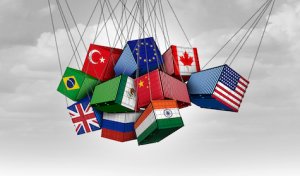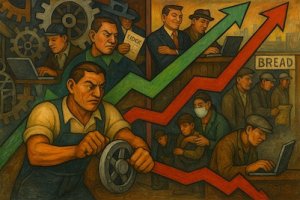Today’s Financial Times articles: Currencies: Strength in Reserve (Feb 8, 2011), Long-term investors shun Treasuries sale (Feb 8, 2011), Fuelling corn’s relentless rise back toward record levels (Feb 10, 2011)
Calls for a new Bretton Woods, a grand international monetary realignment away from the dollar, have come to little, so says the FT. No alternative national currency is a plausible contender, given the “Triffin dilemma”, and potential supranational contenders such as the IMF’s SDR or gold have their own drawbacks.
Instead: “The most likely change is a gradual shift to a multipolar currency world, reflecting increased use of currencies other than the dollar in global trade and finance. China has been encouraging more international use of its currency – permitting, for example, the issuance of renminbi-denominated bonds in Hong Kong. The euro, too, has the potential to take on greater reserve status if the eurozone can sort out its internal economic difficulties and build a government bond market that approaches the US Treasury market for depth and liquidity.”
Here the FT is apparently speaking from the standpoint of the nation state, viewing monetary matters as fundamentally political decisions worked out among the designated leaders of affected states. But there is another voice in these matters, namely the voice of private markets, and it has been speaking as well. What has it been saying?
Put aside the current gold price spike as the voice of nostalgia for a bygone era. Pay attention instead to what is happening with commodity prices generally, and remember some history. Commodity prices are rising; put aside for the moment the current discordant debate about why. The history I’d like to remember is the call for a commodity reserve currency that came out of the interwar period of monetary disorder.
The loudest voice in that call was Benjamin Graham (yes, that Benjamin Graham) in two books— Storage and Stability (1937) and especially World Commodities and World Currency (1944)—although the call was taken up by both Hayek and Keynes in the run-up to the Bretton Woods conference. In brief, the Graham Plan was that international reserve money should be a portfolio of basic commodities, basic in the sense that there is no question of their ultimate sale for use.
In 1944 Graham’s idea went nowhere. In the immediate postwar period, more or less everybody was going to be buying goods from the U.S., so it was dollars that everybody needed, and the system set up at Bretton Woods got organized around the dollar. This was not so much an act of high statesmanship, I would submit, as it was recognition of market reality.
(As against the dollar standard, Graham’s idea was to have an international authority hold warehouse receipts for actual inventories of the basic commodities, and issue currency against those receipts. The authority would stand ready to make a two-way market, trading currency against the commodity bundle, so allowing the quantity of currency to expand or contract as needed while keeping the commodity price level stable. Individual nations would continue to issue their own currencies, convertible into this international currency, and national central banks would hold their international reserves in the form of this international currency.)
Fast forward to today. One way to understand current commodity price movements is as a kind of decentralized market search for a version of the commodity reserve currency plan that might work for today. How so?
Let us accept that the dollar is the international reserve currency, and let us suppose therefore that you are holding dollars but worried about possible instability of the value of the dollar. Suppose further that you are an international holder, so TIPS are not a good hedge.
One way to hedge is to buy futures on a broad commodity index to an amount equal to your dollar reserve holdings. If the dollar falls in value against the referenced commodity portfolio, the payoff from your futures position automatically increases your nominal dollar holding by just enough to keep your real holding constant. The combination of dollar holdings and commodity futures is, in effect, a synthetic commodity reserve currency, but (unlike the Graham Plan) with zero actual inventories of commodities.
The problem is, who is on the other side of the futures contract? Commodity producers no doubt would welcome the chance to hedge their natural long commodity exposure, but they can already do this by trading with commodity consumers. The monetary demand for futures thus has no natural counterpart supply, and so tends to push futures prices away from fundamentals.
This way of looking at current events leads to a somewhat less sanguine conclusion than that offered by the FT. If (and it is admittedly a big if) current commodity price movements are being driven by unbalanced demand in the commodity futures market, then evolutionary change toward a multilateral national currency reserve system will work only if the currencies in question are able to meet that unbalanced demand.
To be continued…





